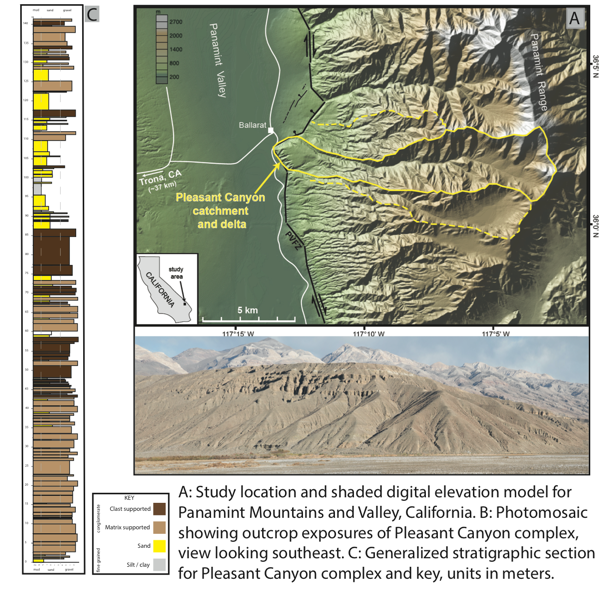Reports: DNI853553-DNI8: Detecting Signals of Sediment Supply in the Stratigraphic Architecture of an Outcropping Pleistocene Delta Complex
Brian W. Romans, Virginia Polytechnic Institute and State University
The first year of this grant was very successful. The Ph.D. student spearheading this work went to the field site twice as planned. The first field excursion was in October 2013 to characterize and map the stratigraphic patterns. This trip yielded data, observations, and preliminary interpretations (Fig. 1) appropriate for student poster presentations at both the 2013 American Geophysical Union fall meeting and the 2014 American Association of Petroleum Geologists annual conference. These data also provided the stratigraphic context and framework with which to design a sampling strategy, which was critical because the overarching goal of the research is to relate the calculated erosion rates directly to the patterns mapped in outcrop. The second trip, in March 2014, had the primary objective of acquiring the first set of samples and a secondary objective to further characterize the sedimentologic and stratigraphic information.
Figure 1: Study area details including measured stratigraphic section showing sedimentologic facies and stratigraphic evolution.
Field sampling was not trivial and the primary Ph.D. student, along with a graduate student assistant, designed and implemented a sampling procedure that involved digging into the outcrop at least 30-40 cm (with a power chisel) followed by disaggregation and sieving of the sample on site. In total, 15 samples were acquired, representing a robust sample set with which to test the novel technique being applied.
In June 2014, these 15 samples were taken to the PRIME Lab at Purdue University to be processed and prepared for accelerator mass spectrometry (AMS). The Ph.D. student spent three weeks at this lab processing the samples via a series of chemical extractions to isolate the appropriate mineral (quartz) and then to prepare the material for AMS measurement of 10Be and 26Al. The results of the AMS measurements were delivered last month (September 2014), which is an extraordinarily rapid turnaround time for sample preparation and AMS measurements. The next phase of this research is to calculate paleo-denudation (the sum of chemical and physical erosion) rates from the raw nuclide concentration data. Because this application is novel there are not yet well-established calculators or software that can account for post-depositional production and decay of cosmogenic nuclides and, thus, part of the research is to develop and test workflows to make these calculations. Therefore, at the time of writing this report, we cannot share any preliminary interpretations of paleo-denudation rates from the first sample set. However, using the same AMS measurements we plan to use to derive paleo-denudation rates, we have interpreted preliminary modern catchment-averaged denudation rates from the Pleasant Canyon and Middle Park catchments on the order or 0.03-0.04 mm/yr, respectively, averaged over timescales of ca. 16-20 ka. These modern denudation rates are typical of this tectonic and climatic landscape and will serve as a useful comparison for the calculated paleo-denudation rates. Other promising preliminary results include a suite of Al/Be burial ages through the stratigraphy that indicate active sedimentation from ~1.2 Ma to ~0.3-0.1 Ma.
Looking forward to the second year of this grant, we first plan to finish analyzing and interpreting the existing data before deciding if a second sampling campaign is necessary. For instance, the duration of active sedimentation to the paleo fan surface could be much longer than initially expected (>1 Ma), and thus, the stratigraphy would reflect numerous glacial-interglacial cycles. One hypothesis is paleo-denudation rate should vary on timescales of orbital forcings (~100 kyr periodicities), and thus an appropriate number of samples should be taken which could capture such changes in rates of sediment supply. Alternatively, the rates we measure may reflect only two to three dominant regimes of sediment supply to the system. In this case, our sampling density could easily capture changes in sediment supply rates and no further sampling would be required. In summary, we are thrilled with the progress of this project after one year and look forward to completing the work over the next and sharing with the scientific community.












